Mausoleums of the Yellow Emperor [courtesy China.org] Huangling County is located on the Loess Plateau of northwest China in Shaanxi Province. It is known for the Yellow Emperor’s tomb, hence the name Huangling of the county.

— INTRO by ANCIENT PATRIARCHS: It is our opinion that there are solid reasons to believe that Huang Di and all other Chinese patriarchs are just as historical as all other ‘legendary’ patriarchs all over the world. Sure, they were deified, their heroic deeds exaggerated & embellished, but the one reason that skepticism has grown these last 100 years, is because of the rich Western control freaks who organised this dis-information campaign against them, under mandates of Darwinism, Cultural Marxism, Atheism, Post Modernism, & Satanism, to break national histories & cultures, in order to equalise & mongrelise humanity, to realise their global pipedream of their NWO slavery system over all nations. —
Huang Di or ‘Yellow Emperor’ is the legendary ancestor of the Chinese nation. His surname is Ji and Xuan Yuan or You Xiong is his name. He led his people to victory over other tribes under the interfering Emperors Yan Di and Chi You and brought unity and stability among them. With those triumphs, he was made leader of union of all the tribes. It is said he taught people silkworm breeding, vessel and vehicle making, characters, temperament, healing art, calculation and so on. Therefore people loved and admired him.
About 4,000-5,000 years ago, i.e. during the late period of primitive society of China, a number of legendary heroes had emerged to conquer nature and improve the lives of the people, among whom were included the Yellow Emperor, Fu Xi, Nu Wa, Shen Nong, Yao, Shun and Yu. (see A.P. chart below, click for big) In their memories, people built many tombs and even had several tombs in different provinces built for the same hero. The Yellow Emperor is one, for example, who had two tombs built in Shaanxi, in addition to others in Henan, Hebei and Gansu provinces.
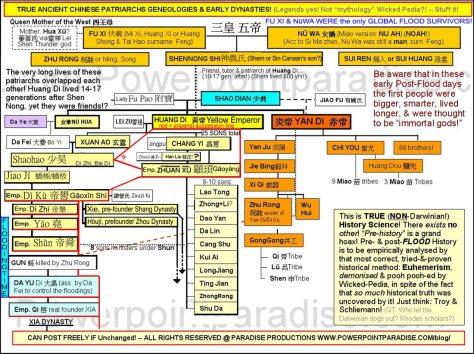
Actually, no one knows for certain about these legendary heroes, and even historical records spring mostly from hearsay. As for their deaths and burial places, the records here are also vague and the stories quite different. Based on what is known of burial practices, tombs as large and lavish as those of legendary heroes could not have been built at the times of their death, neither had mausoleums for sacrifice yet appeared. All the existing mausoleums and buildings, therefore, were built by later generations in their memory, virtually eliminating the possibility that the bodies of the heroes were inside the tombs.
The Yellow Emperor’s tomb is located on Qiaoshan Hill in north Huangling County, one kilometer from the county town. Jushui River runs by the left side of beautiful Qiaoshan. Amid a luxuriant growth of ancient cypresses is the Yellow Emperor’s Tomb, 3.6 meters high and 48 meters in circumference.
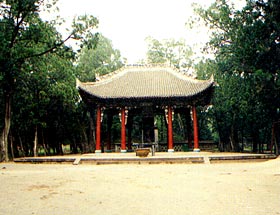 A distant view of the Yellow Emperor Mausoleum
A distant view of the Yellow Emperor Mausoleum
At the entrance of the mausoleum stands a pavilion in which there is a tombstone with the characters ”The Yellow Emperor’s Tomb.” Behind this structure is another pavilion in which stands a stele carrying the characters “Supreme Guidance from Qiaoshan.” Behind it there is a stone tablet erected in 1776 during the reign of Emperor Qian Long of the Qing Dynasty, with the characters “Ancient Yellow Emperor’s Tomb on Qiaoshan.” To the south of it is a large, tall terrace said to have been built by Emperor Wu Di (140-87 BC) of the Han Dynasty for prayer and for offering sacrifice to the Yellow Emperor over 2,000 years ago after he returned from his expedition to the northern territory of the country.
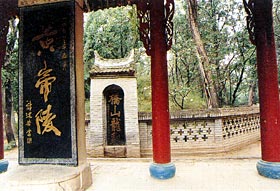 Tombstone and grave mound of the Yellow Emperor Mausoleum
Tombstone and grave mound of the Yellow Emperor Mausoleum

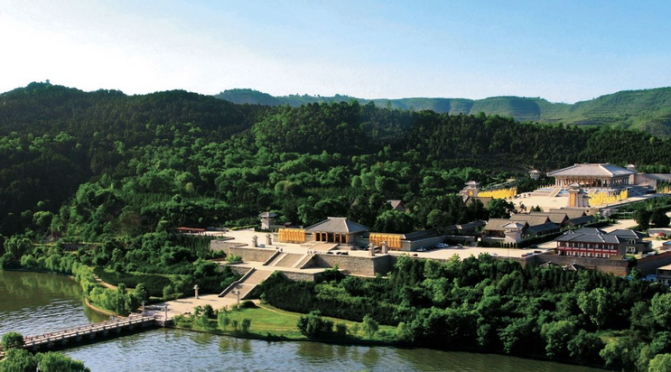

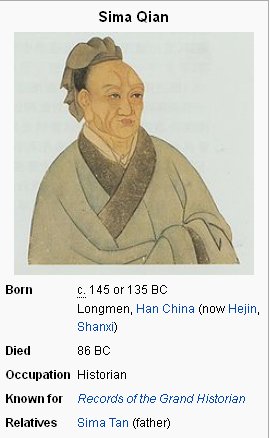 Another part of the Shi Ji annals written by the Han historian Sima Qian a century before the time of Jesus. Shima Qian referred to ancient sources in his writings, that are not extant anymore. This chapter is about Yu the Great – Da Yu – whose father Gun failed to control the post Flood swelling lakes and rivers, and paid for it with his life! He was slain by ZhuRong
Another part of the Shi Ji annals written by the Han historian Sima Qian a century before the time of Jesus. Shima Qian referred to ancient sources in his writings, that are not extant anymore. This chapter is about Yu the Great – Da Yu – whose father Gun failed to control the post Flood swelling lakes and rivers, and paid for it with his life! He was slain by ZhuRong
